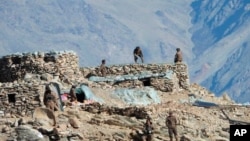The resolution of a two-year border standoff between China and India has eased tensions between the Asian giants but left Indian critics saying their government gave up too much, local herders complaining of lost pastureland and analysts warning another escalation could come at any time.
The two nations’ militaries have disengaged from a border point in the Gogra-Hot Springs region in eastern Ladakh in accordance with an agreement reached in September, resolving one of several simmering border disputes that have kept the two countries on edge.
The Chinese withdrawal was confirmed in recent satellite imagery shared on Twitter by open-source intelligence analyst, Damien Symon, who tweeted, “imagery of Chinese side confirms what used to be a border camp, has now been removed, depth deployments, however, remain.”
But Pravin Sawhney, a former Indian army officer and widely published defense analyst, argued in an interview that China’s People’s Liberation Army “are not going back an inch” from the land they occupied more than two years ago. “The disengagements that have happened and the buffer zone that has been created are about 6 kilometers inside Indian territory,” he said.
Sawhney also pointed out that Chinese troops remain on land claimed by India in other critical areas of the Himalayan border region, including the Depsang Plains adjoining the Siachen Glacier, a militarily sensitive region bordered by India, China and Pakistan.
“In case of war, the Depsang Plains would be critical as it could facilitate one-front reinforced war with China and Pakistan,” Sawhney said.
Indian National Congress member Rahul Gandhi, a former leader of the opposition Congress Party, has also complained about the deal in a tweet.
“China has refused to accept India’s demand of restoring status quo of April 2020. [Prime Minister Narendra Modi] has given 1000 [square kilometers] of territory to China without a fight. Can [the government of India] explain how this territory will be retrieved?”
Sajjad Kargili, a political activist from the Ladakh region in Indian-administered Kashmir, told VOA that while the easing of tensions has been welcomed in the region, local herders are resentful at being shut out of their former grazing land in what is now part of the buffer zone.
“We have witnessed and lost access to our traditional grazing area, and now nomads have to move around over 15 kilometers to feed their livestock,” said Konchok Stanzin, who represents a border constituency on a local council. “The government should provide compensation to keep alive nomads’ culture and tradition in eastern Ladakh.”
He and others say the loss of the grazing land threatens the Pashmina wool business, which has been in operation for over 600 years and provides livelihoods for over a quarter of a million people.
Aparna Pande, research fellow and director at the Hudson Institute’s Initiative on the Future of India and South Asia, sees the Gogra-Hot Springs dispute as part of what some have described as Chinese “salami-slicing,” a strategy that “entails taking over territory and then claiming it as Chinese and asking the other to just accept reality and move on.”
“Between 2012 and 2020, there were four different occasions when the PLA came in and took over Indian territory along the border and each time while India disengaged and withdrew its troops, China did not reciprocate,” she said. “This time, India has disengaged but the extra troops will only be withdrawn if, and when, China does the same.”
Michael Kugelman, deputy director of the Asia program at the Wilson Center, a Washington-based research group, noted that China remains unhappy with India for several reasons, including its participation with Japan, Australia and the United States in a security dialogue known as “the Quad.”
“China perceives the Quad and the countries that comprise it as part of an emerging military alliance bent on containing China,” Kugelman said in an interview.
“If [China] wants to stage another provocation, it can do that, and New Delhi has little capacity to deter it,” he said. “In fact, even with the recent disengagement, there are some indications that there are still some Chinese troops hunkered down on Indian territory.”
A more optimistic view was expressed by Yun Sun, a senior fellow and co-director of the East Asia Program at the Washington-based Stimson Center, who believes that neither country wants to see a repeat of the 2020 crisis.
“I don’t think either side will take the light decision to escalate again,” Sun told VOA. “We will see a prolonged period of stalemate, with both sides strengthening their control on their side” of the Line of Actual Control, or LAC.
India’s involvement in the Quad is an annoyance for China, Sun acknowledged, but “until that involvement translates into material impact on the border, I don’t think China will take actions to push back.”
“Trade is development on its own track,” she added. “I don’t expect an economic decoupling between the two countries in the foreseeable future.”
On the latter point, Kugelman agreed, saying, “New Delhi’s economic interests require continued trade with China, and I don’t see that calculus changing anytime soon.”







